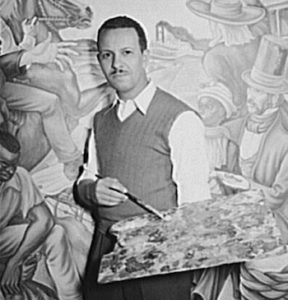
Hale Woodruff
This date recalls the birth of Hale Woodruff in 1900. He was a Black artist.
He was born in Cairo, Illinois, but after his father died when he was very young, his mother, Augusta, moved them to Nashville, TN. With encouragement from her, Woodruff began to copy newspaper cartoons and images in the family Bible, and at Pearl High School, he was the school’s newspaper cartoonist. After graduation and a brief summer job as a hotel houseboy in Indianapolis, he began art studies at Herron Art Institute.
While there, he became friendly with German-born Herman Lieber, who gave him a book entitled “Afrikanische Plastik” by Carl Einstein in 1923. Fifty years later, Woodruff still treasured this book. It made him one of the first Black artists to study African art intensively and be influenced by it. At the height of the Harlem Renaissance in 1927, Woodruff made his trip abroad, funded partly by a Harmon Foundation award and sales of his Harmon Award-winning paintings in Indianapolis.
Woodruff's European works were in the cubist mode. The Card Players, 1928-29, was inspired by Pablo Picasso's cubist style and Cézanne's Two Card Players, 1890-92. Medieval Chartres from 1927 through 1929 is another example. Woodruff's style changed when he returned to the U. S. in 1931. He accepted a position as the first art instructor at the (now) Clark Atlanta University Center, where he began showing interest in regionalism and social realism, dominant styles of the Depression era. Almost half of Woodruff's career was spent in Atlanta, where he painted several figure studies, including Troubadour, Cigarette Smoker, and Sharecropper Boy. At this time, Woodruff married Theresa Ada Baker, a teacher from Topeka, Kansas; they had one son, Roy, who was born in 1935. While in Atlanta, Woodruff initiated a national exhibition of works by black artists held annually from 1942 to 1970 at Atlanta University.
Also known for mural painting, he spent the summer of 1936 in Mexico mixing colors and preparing walls for Mexican muralist Diego Rivera. He was later commissioned to create murals, which are still intact, at Talladega College in Alabama and the Trevor Arnett Library at Clark Atlanta University. The Trevor Arnett Library murals are called The Art of the Negro (1950).
Woodruff's research and absorption of African cultural ideas became the foundation for his subsequent work, including paintings like Carnival and Afro Emblems. 1943, Woodruff received a Julius Rosenwald fellowship to paint in New York City. There, he finished the Atlanta University murals. He soon came under the influence of abstract expressionism, and his style shifted to what he described as "semiabstract, symbolic painting." He continued to paint abstractly for the rest of his life.
Woodruff was a founding member of Spiral, a group of over a dozen Black artists who joined in New York City in 1962 to explore their common cultural experiences as Black artists. He proposed the name to suggest the group's need to reach broader circles. Woodruff was promoted to professor of education at New York University in 1957, and in 1967, the university honored him with a retrospective exhibition of his paintings. In 1966, he showed slides of his Amistad murals in Sierra Leone to descendants of the mutineers who made African and American history.
In 1968, he retired from the university and was named Professor Emeritus. In the spring of 1979, the Studio Museum in Harlem held a retrospective of Woodruff's art, covering 50 years of his work. Through his work, Hale Woodruff was a true voice of American Civil Rights. He died in 1980 at age 80.
The St. James Guide to Black Artists
Edited by Thomas Riggs
Copyright 1997, St. James Press, Detroit, MI
ISBN 1-55862-220-9